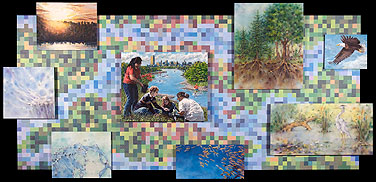News
Painting conveys complex science

“Streams of Thought,” a painting by Gary Wolfe and Priscilla Bowen, conveys the collaborative nature of the UB doctoral program Ecosystem Restoration Through Interdisciplinary Exchange.
UB students are being trained in the interdisciplinary field of ecosystem restoration, in which they learn how to restore ecosystems damaged by natural or manmade influences. But communicating this new, multidisciplinary science to the outside world—or even to one another—has been a challenge.
So they asked some local artists for help.
The result is a door-sized, three-dimensional painting that aims to depict the complexity of ecosystems, as well as the nature of human interactions with them.
The commissioned work, “Streams of Thought,” was unveiled at an opening reception on Aug. 7 in the Center for the Arts.
“Our program office is located in the School of Engineering and Applied Sciences, but it involves seven academic departments in three different units throughout the university,” says Alan Rabideau, professor in the Department of Civil, Structural and Environmental Engineering and director of the "Ecosystem Restoration Through Interdisciplinary Exchange" (ERIE) program, funded by the National Science Foundation. “We wanted to create an office space that speaks to everyone who’s involved in it.”
A doctoral training program launched in 2007, ERIE was designed to train a new generation of environmental specialists who will be as comfortable with the social and policy implications of their work as they are with its scientific aspects. Students in ERIE follow academic programs and conduct research projects designed to advance the science, engineering and policies of ecosystem restoration, as well as aid in the ecological recovery of the Great Lakes and Western New York.
In addition to the Department of Civil, Structural and Environmental Engineering, the project involves the collaboration of students and scholars from the departments of American Studies, Biological Sciences, Chemistry, Geography, Geological Sciences and Philosophy, all in the College of Arts and Sciences.
“One of the things we discuss when we talk about environmental restoration is that people value nature for many different reasons,” says Rabideau. “Engineers tend to focus on particular values, like protecting infrastructure from wandering streams or looking at the economic benefits of ecologic services. But it’s also important to look at why the broader community values ecosystems. One reason is aesthetics. Another important concept that our Native American scholars emphasize is that ecological restoration must address the complex relationship between humans and their local places.”
Artists Gary Wolfe and Priscilla Bowen spent about six months working on the project. Wolfe, a UB alumnus, is a visual artist and past president of the Buffalo Society of Artists, whose work has been exhibited in the region and beyond. His two- and three-dimensional works combine painting, drawing, collage and assemblage. Bowen is a visual artist whose work focuses on representing the mystery and beauty of nature. Her work has been exhibited widely in Western New York.
According to Rabideau, the artists decided to take a collaborative approach to the painting in order to mirror the collaborations of the ERIE program.
Working from diagrams provided by the UB scientists that depict the interdependence of ecosystems, the artists created as the background of the piece an aerial perspective of streams moving through the landscape.
Each artist then developed four panels that were attached to that background to show specific ways that scientists, scholars and communities interact with ecosystems.
“This was a collaborative piece,” explains Wolfe. “In the painting, you see the individual and also the landscape as a whole. We believe the two were melded together in an interesting way. That’s kind of reflective of what the ERIE scholars are doing, pulling together all these different academic departments, but each still retaining their individual flavor.”
The painting’s permanent home is in 202 Jarvis Hall, North Campus.

Reader Comments